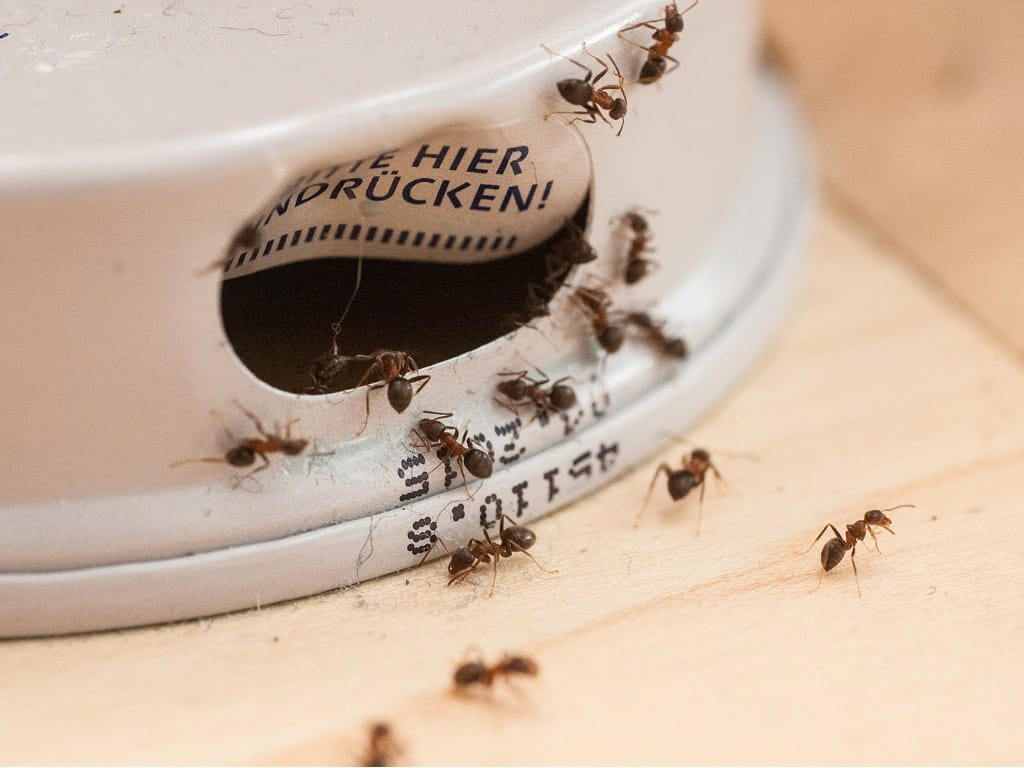Is Ant Bait Safe Around Children?

The Bottom Line
Ant bait products are usually a combination of a food attractive to ants and an insecticide. Generally, unintentional exposures to ant baits pose little risk of toxicity due to their low concentration. Toddlers who taste ant bait products might develop nausea and vomiting. Contact with the skin or eyes can cause irritation.

How does ant bait work?
Ant colonies include a queen, worker ants, and a brood (immature ants). The queen is responsible for laying eggs, so she stays deep within the protection of the nest. The worker ants are responsible for leaving the nest in search of food and bringing the food back to the colony. Eliminating an ant colony requires killing all the ants, including the queen and brood.
Methods for dealing with ants generally fall into two categories: repellents and insecticides. Repellents discourage ants from entering a specific area. These products create a barrier that ants do not want to cross. However, they might still find other entry points into the home.
Ant baits contain a combination of ant food and insecticide. Insecticides kill the ants. The food attracts ants, and the worker ants then transport the insecticide-laced food back to the colony. The insecticide is shared with all the other ants, including the queen and brood, thereby killing the whole colony. This strategy means that the ants do not die immediately after encountering the bait, since they live long enough to return to the colony to share the poisoned food. The bait can initially attract more ants to the area because of the food. Bait manufacturers indicate it can take many days to weeks for ants to completely disappear from an area.
How do you use ant bait?
Ant baits are available in a variety of forms, including liquids, gels, solids, and granules. The liquid and gel baits are available in small bottles, tubes, or prefilled syringes. The liquid is applied to a piece of cardboard and placed in an area where ants are common. The gels can be placed directly on surfaces and in cracks. Liquid, gel, and solid baits are also available encased in plastic containers that are placed in areas where ants have been seen.
These products are sometimes referred to as bait stations and are designed to let ants in but keep children and pets out. Many bait products can be used indoors or outdoors, including in food preparation areas. However, some baits are strictly for outdoor use. Carefully read the ant bait product label and follow the instructions for use.
What is ant bait made of?
A variety of insecticides are used in ant baits. The package label will list the insecticide under the active ingredients. Common insecticides include sodium tetraborate decahydrate (borax), fipronil, avermectin, indoxacarb, and hydramethylnon. These active ingredients have uses other than as ant baits. Borax is found in some laundry detergents, while fipronil, avermectin, and indoxacarb are used in veterinary medicine to prevent infestation of fleas and ticks or to rid animals of these parasites.
Borax kills primarily by acting as a stomach poison. Fipronil, avermectin, and indoxacarb poison an ant's nervous system, causing paralysis and death. Hydramethylnon interferes with a cell's ability to produce energy. Fortunately, many of these insecticides do not work the same way in humans or are in such low concentrations in the baits as to have a low risk of unintentional poisoning.
Is ant bait poisonous to humans?
Ant bait’s toxic effects on humans differ depending on the insecticide. Unintentional ingestion of small amounts of borax or boric acid can cause nausea, vomiting, abdominal pain, and diarrhea. The vomit and stool can be blue green in color. Ingestion of larger amounts can cause a red skin rash followed by skin loss as well as seizures and coma.
The concentration of borax in many ant baits is about 5%, a relatively small amount. Fipronil, avermectin, and indoxacarb all have the potential to affect the nervous system in humans. Ingestion of large amounts can cause weakness, dizziness, or coma. Indoxacarb also has the potential to cause methemoglobinemia, which interferes with red blood cells' ability to deliver oxygen to the body. The concentration of these insecticides in ant baits is generally less than 0.05%. A toddler ingesting the contents of a typical bait station would not get enough insecticide to be dangerous.
Finally, hydramethylnon is low in toxicity overall. Ant baits containing hydramethylnon should not cause effects more severe than nausea, vomiting, or minor diarrhea if ingested.
Is ant bait harmful to the skin and eyes?
The insecticides in ant bait products are not well absorbed across the skin into the body, so getting some on the skin is not expected to cause body-wide effects. However, contact with the skin or eyes can cause irritation.
Can you make safe homemade ant bait?
There are many formulas for making your own ant bait. In general, they combine a form of attractive food (such as sugar, honey, or peanut butter) and borax. Sugar dissolved in water or honey will result in a liquid bait that can be set out in bottle caps. Peanut butter mixed with borax will make a solid bait that can be put on pieces of cardboard.
My child ate ant bait. What should I do?
Ingestion of ant baits should be treated by rinsing out the mouth and drinking a few sips of water. Contact with the skin or eyes requires rinsing as well. Then check the webPOISONCONTROL online tool or call Poison Control at 1-800-222-1222. Whether online or by phone, expert and confidential help is available 24 hours a day.
Karen D. Dominguez, PharmD
Certified Specialist in Poison Information
Professor of Pharmacy Emeritus
Poison Control Media Information
Did you find this page helpful? If so, we need your support. Poison Control is in constant competition with misinformation online. Links to www.poison.org or our webPOISONCONTROL triage tool from other websites and blogs help internet searchers quickly find accurate information and Poison Control’s contact information in an emergency. If you use the content from this page, please provide attribution via a link back to this page, www.poison.org, or https://triage.webpoisoncontrol.org/#!/exclusions. By doing so, you could save a life. Thank you!
Poisoned?
Call 1-800-222-1222 or
Prevention Tips
- Follow the manufacturer's directions for use of ant baits.
- Keep ant baits out of the reach of children.
- Wash hands after handling ant baits.
- Do not pry open ant bait stations.
- Store unused ant bait in its original packaging.
- Do not place ant bait near children's toys or play areas.
This Really Happened
The father of a 2-year-old boy called Poison Control minutes after the boy was found holding a liquid ant bait product next to his mouth. Some of the liquid had spilled onto the floor, but it was unclear how much, if any, the boy had swallowed. The product contained 5.4% sodium tetraborate decahydrate (borax). After asking about the package size, Poison Control determined that the boy did not ingest a toxic dose and could be managed at home. Treatment recommendations were to rinse the boy's mouth and any skin that came into contact with the bait. The father was told to watch for vomiting, diarrhea, or a skin rash. Follow-up calls were made to the father over the next few days, and the boy never developed any effects.For More Information
References
Chung K, Yang CC, Wu ML, Deng JF, Tsai WJ. Agricultural avermectins: an uncommon but potentially fatal cause of pesticide poisoning. Ann Emerg Med. 1999;34(1):51-57.
Holland MG. insecticides: organic chlorines, pyrethrins/pyrethroids, and insect repellents. In: Nelson LS, Howland MA, Lewin NA, Smith SW, Goldfrank LR, Hoffman RS, eds. Goldfrank's Toxicologic Emergencies, 11th ed. McGraw-Hill Education; 2019. Accessed April 7, 2024.
Hydramethylnon general fact sheet. National Pesticide Information Center, Oregon State University. Reviewed September, 2002. Accessed April 7, 2024.
Jackson D, Cornell CB, Luukinen B, Buhl K. Fipronil general fact sheet. National Pesticide Information Center, Oregon State University. Reviewed July, 2009. Accessed April 7, 2024.
Jin K. Rhabdomyolysis, methemoglobinemia and acute kidney injury after indoxacarb poisoning. Clin Toxicol (Phila). 2012;50(3):227.
Sugar boric acid bait for ants. Cooperative Extension Service, University of Hawai’i at Mānoa. March 31, 2012. Accessed April 7, 2024.
Poisoned?
Call 1-800-222-1222 or
Prevention Tips
- Follow the manufacturer's directions for use of ant baits.
- Keep ant baits out of the reach of children.
- Wash hands after handling ant baits.
- Do not pry open ant bait stations.
- Store unused ant bait in its original packaging.
- Do not place ant bait near children's toys or play areas.
